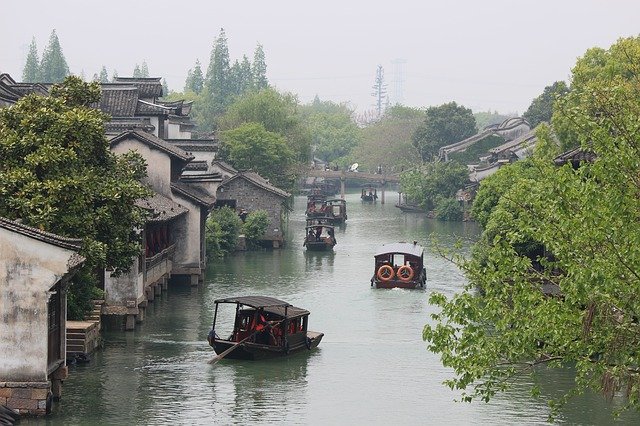El Niño - Wikipedia
文章推薦指數: 80 %
'The Boy') is the warm phase of the El Niño–Southern Oscillation (ENSO) and is associated with a band of warm ocean water that develops in the central and east- ... ElNiño FromWikipedia,thefreeencyclopedia Jumptonavigation Jumptosearch WarmphaseofacyclicclimaticphenomenoninthePacificOcean Forotheruses,seeElNiño(disambiguation). NormalPacificpattern:Warmpoolinthewestdrivesdeepatmosphericconvection.Intheeastlocalwindscausenutrient-richcoldwatertoupwellattheEquatorandalongtheSouthAmericancoast.(NOAA/PMEL/TAO)ElNiñoconditions:warmwaterandatmosphericconvectionmoveeastwards.InstrongElNiñosthedeeperthermoclineoffS.Americameansupwelledwateriswarmandnutrientpoor. ElNiño(/ɛlˈniːn.joʊ/;Spanish: [elˈniɲo];lit. 'TheBoy')isthewarmphaseoftheElNiño–SouthernOscillation(ENSO)andisassociatedwithabandofwarmoceanwaterthatdevelopsinthecentralandeast-centralequatorialPacific(approximatelybetweentheInternationalDateLineand120°W),includingtheareaoffthePacificcoastofSouthAmerica.TheENSOisthecycleofwarmandcoldseasurfacetemperature(SST)ofthetropicalcentralandeasternPacificOcean.ElNiñoisaccompaniedbyhighairpressureinthewesternPacificandlowairpressureintheeasternPacific.ElNiñophasesareknowntolastclosetofouryears;however,recordsdemonstratethatthecycleshavelastedbetweentwoandsevenyears.DuringthedevelopmentofElNiño,rainfalldevelopsbetweenSeptember–November.[clarificationneeded][1]ThecoolphaseofENSOisSpanish:LaNiña,lit. 'TheGirl',withSSTsintheeasternPacificbelowaverage,andairpressurehighintheeasternPacificandlowinthewesternPacific.TheENSOcycle,includingbothElNiñoandLaNiña,causesglobalchangesintemperatureandrainfall.[2][3] Developingcountriesthatdependontheirownagricultureandfishing,particularlythoseborderingthePacificOcean,areusuallymostaffected.InthisphaseoftheOscillation,thepoolofwarmwaterinthePacificnearSouthAmericaisoftenatitswarmestaboutChristmas.[4]Theoriginalphrase,ElNiñodeNavidad,arosecenturiesago,whenPeruvianfishermennamedtheweatherphenomenonafterthenewbornChrist.[5][6] Contents 1Concept 2Occurrences 3Culturalhistoryandprehistoricinformation 4Diversity 5Effectsontheglobalclimate 5.1Tropicalcyclones 5.2RemoteinfluenceontropicalAtlanticOcean 6Regionalimpacts 6.1Africa 6.2Antarctica 6.3Asia 6.4AustraliaandtheSouthernPacific 6.5Europe 6.6NorthAmerica 6.7SouthAmerica 7Socio-ecologicaleffectsforhumanityandnature 7.1Economicaleffects 7.2Healthandsocialimpacts 7.3Ecologicalconsequences 8References 9Furtherreading 10Externallinks Concept[edit] Originally,thetermElNiñoappliedtoanannualweakwarmoceancurrentthatransouthwardsalongthecoastofPeruandEcuadorataboutChristmastime.[7]However,overtimethetermhasevolvedandnowreferstothewarmandnegativephaseoftheElNiño–SouthernOscillationandisthewarmingoftheoceansurfaceorabove-averageseasurfacetemperaturesinthecentralandeasterntropicalPacificOcean.[8][9]ThiswarmingcausesashiftintheatmosphericcirculationwithrainfallbecomingreducedoverIndonesia,IndiaandnorthernAustralia,whilerainfallandtropicalcycloneformationincreasesoverthetropicalPacificOcean.[10]Thelow-levelsurfacetradewinds,whichnormallyblowfromeasttowestalongtheequator,eitherweakenorstartblowingfromtheotherdirection.[9] Loopofwarmingseasurfacetemperature(SST)anomaliesintheTropicalPacific ItisbelievedthatElNiñohasoccurredforthousandsofyears.[11]Forexample,itisthoughtthatElNiñoaffectedtheMocheinmodern-dayPeru.ScientistshavealsofoundchemicalsignaturesofwarmerseasurfacetemperaturesandincreasedrainfallcausedbyElNiñoincoralspecimensthatarearound13,000 yearsold.[12]Around1525,whenFranciscoPizarromadelandfallinPeru,henotedrainfallinthedeserts,thefirstwrittenrecordoftheimpactsofElNiño.[12]Moderndayresearchandreanalysistechniqueshavemanagedtofindatleast26ElNiñoeventssince1900,withthe1982–83,1997–98and2014–16eventsamongthestrongestonrecord.[13][14][15] Currently,eachcountryhasadifferentthresholdforwhatconstitutesanElNiñoevent,whichistailoredtotheirspecificinterests.[16]Forexample,theAustralianBureauofMeteorologylooksatthetradewinds,SOI,weathermodelsandseasurfacetemperaturesintheNiño3and3.4regions,beforedeclaringanElNiño.[17]TheUnitedStatesClimatePredictionCenter(CPC)andtheInternationalResearchInstituteforClimateandSociety(IRI)looksattheseasurfacetemperaturesintheNiño3.4region,thetropicalPacificatmosphereandforecaststhatNOAA'sOceanicNiñoIndexwillequalorexceed+.5 °C(0.90 °F)forseveralseasonsinarow.[18]However,theJapanMeteorologicalAgencydeclaresthatanElNiñoeventhasstartedwhentheaveragefivemonthseasurfacetemperaturedeviationfortheNINO.3region,isover0.5 °C(0.90 °F)warmerforsixconsecutivemonthsorlonger.[19]ThePeruviangovernmentdeclaresthatacoastalElNiñoisunderwayiftheseasurfacetemperaturedeviationintheNiño1and2regionsequalorexceed0.4 °C(0.72 °F)foratleastthreemonths. Thereisnoconsensuswhetherclimatechangewillhaveanyinfluenceontheoccurrence,strengthordurationofElNiñoevents,asresearchsupportsElNiñoeventsbecomingstronger,longer,shorterandweaker.[20][21]However,recentscholarshiphasfoundthatclimatechangeisincreasingthefrequencyofextremeElNiñoevents.[22][23] Occurrences[edit] AtimelineofalltheElNiñoepisodesbetween1900and2022.[13][14] ElNiñoeventsarethoughttohavebeenoccurringforthousandsofyears.[11]Forexample,itisthoughtthatElNiñoaffectedtheMocheinmodern-dayPeru,whosacrificedhumansinordertotrytopreventtherains.[24] Itisthoughtthattherehavebeenatleast30ElNiñoeventssince1900,withthe1982–83,1997–98and2014–16eventsamongthestrongestonrecord.[13][14]Since2000,ElNiñoeventshavebeenobservedin2002–03,2004–05,2006–07,2009–10,2014–16,[13]and2018–19.[25][26] MajorENSOeventswererecordedintheyears1790–93,1828,1876–78,1891,1925–26,1972–73,1982–83,1997–98,and2014–16.[27][28][29] Typically,thisanomalyhappensatirregularintervalsoftwotosevenyears,andlastsninemonthstotwoyears.[30]Theaverageperiodlengthisfiveyears.Whenthiswarmingoccursforseventoninemonths,itisclassifiedasElNiño"conditions";whenitsdurationislonger,itisclassifiedasanElNiño"episode".[31] DuringstrongElNiñoepisodes,asecondarypeakinseasurfacetemperatureacrossthefareasternequatorialPacificOceansometimesfollowstheinitialpeak.[32] Culturalhistoryandprehistoricinformation[edit] AverageequatorialPacifictemperatures ENSOconditionshaveoccurredattwo-toseven-yearintervalsforatleastthepast300years,butmostofthemhavebeenweak.EvidenceisalsostrongforElNiñoeventsduringtheearlyHoloceneepoch10,000yearsago.[33] ElNiñomayhaveledtothedemiseoftheMocheandotherpre-ColumbianPeruviancultures.[34]ArecentstudysuggestsastrongElNiñoeffectbetween1789and1793causedpoorcropyieldsinEurope,whichinturnhelpedtouchofftheFrenchRevolution.[35]TheextremeweatherproducedbyElNiñoin1876–77gaverisetothemostdeadlyfaminesofthe19thcentury.[36]The1876faminealoneinnorthernChinakilledupto13millionpeople.[37] Anearlyrecordedmentionoftheterm"ElNiño"torefertoclimateoccurredin1892,whenCaptainCamiloCarrillotoldthegeographicalsocietycongressinLimathatPeruviansailorsnamedthewarmsouth-flowingcurrent"ElNiño"becauseitwasmostnoticeablearoundChristmas.[38]Thephenomenonhadlongbeenofinterestbecauseofitseffectsontheguanoindustryandotherenterprisesthatdependonbiologicalproductivityofthesea.Itisrecordedthatasearlyas1822,cartographerJosephLartigue,oftheFrenchfrigateLaClorindeunderBaronMackau,notedthe"counter-current"anditsusefulnessfortravelingsouthwardalongthePeruviancoast.[39][40][41] CharlesTodd,in1888,suggesteddroughtsinIndiaandAustraliatendedtooccuratthesametime;[42]NormanLockyernotedthesamein1904.[43]AnElNiñoconnectionwithfloodingwasreportedin1894byVictorEguiguren(1852–1919)andin1895byFedericoAlfonsoPezet(1859–1929).[44][40][45]In1924,GilbertWalker(forwhomtheWalkercirculationisnamed)coinedtheterm"SouthernOscillation".[46]Heandothers(includingNorwegian-AmericanmeteorologistJacobBjerknes)aregenerallycreditedwithidentifyingtheElNiñoeffect.[47] Themajor1982–83ElNiñoledtoanupsurgeofinterestfromthescientificcommunity.Theperiod1990–95wasunusualinthatElNiñoshaverarelyoccurredinsuchrapidsuccession.[48][49][50]AnespeciallyintenseElNiñoeventin1998causedanestimated16%oftheworld'sreefsystemstodie.Theeventtemporarilywarmedairtemperatureby1.5 °C,comparedtotheusualincreaseof0.25 °CassociatedwithElNiñoevents.[51]Sincethen,masscoralbleachinghasbecomecommonworldwide,withallregionshavingsuffered"severebleaching".[52] Diversity[edit] MapshowingNiño3.4andotherindexregions ItisthoughtthatthereareseveraldifferenttypesofElNiñoevents,withthecanonicaleasternPacificandtheModokicentralPacifictypesbeingthetwothatreceivethemostattention.[53][54][55]ThesedifferenttypesofElNiñoeventsareclassifiedbywherethetropicalPacificseasurfacetemperature(SST)anomaliesarethelargest.[55]Forexample,thestrongestseasurfacetemperatureanomaliesassociatedwiththecanonicaleasternPacificeventarelocatedoffthecoastofSouthAmerica.[55]ThestrongestanomaliesassociatedwiththeModokicentralPacificeventarelocatedneartheInternationalDateLine.[55]However,duringthedurationofasingleevent,theareawiththegreatestseasurfacetemperatureanomaliescanchange.[55] ThetraditionalNiño,alsocalledEasternPacific(EP)ElNiño,[56]involvestemperatureanomaliesintheEasternPacific.However,inthelasttwodecades,atypicalElNiñoswereobserved,inwhichtheusualplaceofthetemperatureanomaly(Niño1and2)isnotaffected,butananomalyarisesinthecentralPacific(Niño3.4).[57]ThephenomenoniscalledCentralPacific(CP)ElNiño,[56]"dateline"ElNiño(becausetheanomalyarisesneartheInternationalDateLine),orElNiño"Modoki"(ModokiisJapanesefor"similar,butdifferent").[58][59][60][61] TheeffectsoftheCPElNiñoaredifferentfromthoseofthetraditionalEPElNiño—e.g.,therecentlydiscoveredElNiñoleadstomorehurricanesmorefrequentlymakinglandfallintheAtlantic.[62] Thereisalsoascientificdebateontheveryexistenceofthis"new"ENSO.Indeed,anumberofstudiesdisputetherealityofthisstatisticaldistinctionoritsincreasingoccurrence,orboth,eitherarguingthereliablerecordistooshorttodetectsuchadistinction,[63][64]findingnodistinctionortrendusingotherstatisticalapproaches,[65][66][67][68][69]orthatothertypesshouldbedistinguished,suchasstandardandextremeENSO.[70][71] ThefirstrecordedElNiñothatoriginatedinthecentralPacificandmovedtowardtheeastwasin1986.[72]RecentCentralPacificElNiñoshappenedin1986–87,1991–92,1994–95,2002–03,2004–05and2009–10.[73]Furthermore,therewere"Modoki"eventsin1957–59,[74]1963–64,1965–66,1968–70,1977–78and1979–80.[75][76]SomesourcessaythattheElNiñosof2006-07and2014-16werealsoCentralPacificElNiños.[77][78] Effectsontheglobalclimate[edit] ColoredbarsshowhowElNiñoyears(red,regionalwarming)andLaNiñayears(blue,regionalcooling)relatetooverallglobalwarming.ElNiñoyearsusuallycorrespondtoannualglobaltemperatureincreases. ElNiñoaffectstheglobalclimateanddisruptsnormalweatherpatterns,whichasaresultcanleadtointensestormsinsomeplacesanddroughtsinothers.[79][80] Tropicalcyclones[edit] Mosttropicalcyclonesformonthesideofthesubtropicalridgeclosertotheequator,thenmovepolewardpasttheridgeaxisbeforerecurvingintothemainbeltoftheWesterlies.[81]AreaswestofJapanandKoreatendtoexperiencemanyfewerSeptember–NovembertropicalcycloneimpactsduringElNiñoandneutralyears.DuringElNiñoyears,thebreakinthesubtropicalridgetendstolienear130°E,whichwouldfavortheJapanesearchipelago.[82] WithintheAtlanticOceanverticalwindshearisincreased,whichinhibitstropicalcyclonegenesisandintensification,bycausingthewesterlywindsintheatmospheretobestronger.[83]TheatmosphereovertheAtlanticOceancanalsobedrierandmorestableduringElNiñoevents,whichcanalsoinhibittropicalcyclonegenesisandintensification.[83]WithintheEasternPacificbasin:ElNiñoeventscontributetodecreasedeasterlyverticalwindshearandfavoursabove-normalhurricaneactivity.[84]However,theimpactsoftheENSOstateinthisregioncanvaryandarestronglyinfluencedbybackgroundclimatepatterns.[84]TheWesternPacificbasinexperiencesachangeinthelocationofwheretropicalcyclonesformduringElNiñoevents,withtropicalcycloneformationshiftingeastward,withoutamajorchangeinhowmanydevelopeachyear.[83]Asaresultofthischange,Micronesiaismorelikelytobeaffectedbytropicalcyclones,whileChinahasadecreasedriskofbeingaffectedbytropicalcyclones.[82]AchangeinthelocationofwheretropicalcyclonesformalsooccurswithintheSouthernPacificOceanbetween135°Eand120°W,withtropicalcyclonesmorelikelytooccurwithintheSouthernPacificbasinthantheAustralianregion.[10][83]Asaresultofthischangetropicalcyclonesare50%lesslikelytomakelandfallonQueensland,whiletheriskofatropicalcycloneiselevatedforislandnationslikeNiue,FrenchPolynesia,Tonga,Tuvalu,andtheCookIslands.[10][85][86] RemoteinfluenceontropicalAtlanticOcean[edit] AstudyofclimaterecordshasshownthatElNiñoeventsintheequatorialPacificaregenerallyassociatedwithawarmtropicalNorthAtlanticinthefollowingspringandsummer.[87]AbouthalfofElNiñoeventspersistsufficientlyintothespringmonthsfortheWesternHemisphereWarmPooltobecomeunusuallylargeinsummer.[88]Occasionally,ElNiño'seffectontheAtlanticWalkercirculationoverSouthAmericastrengthenstheeasterlytradewindsinthewesternequatorialAtlanticregion.Asaresult,anunusualcoolingmayoccurintheeasternequatorialAtlanticinspringandsummerfollowingElNiñopeaksinwinter.[89]CasesofElNiño-typeeventsinbothoceanssimultaneouslyhavebeenlinkedtoseverefaminesrelatedtotheextendedfailureofmonsoonrains.[27] Regionalimpacts[edit] ObservationsofElNiñoeventssince1950showthatimpactsassociatedwithElNiñoeventsdependonthetimeofyear.[90]However,whilecertaineventsandimpactsareexpectedtooccurduringevents,itisnotcertainorguaranteedthattheywilloccur.[90]TheimpactsthatgenerallydooccurduringmostElNiñoeventsincludebelow-averagerainfalloverIndonesiaandnorthernSouthAmerica,whileaboveaveragerainfalloccursinsoutheasternSouthAmerica,easternequatorialAfrica,andthesouthernUnitedStates.[90] Africa[edit] InAfrica,EastAfrica—includingKenya,Tanzania,andtheWhiteNilebasin—experiences,inthelongrainsfromMarchtoMay,wetter-than-normalconditions.ConditionsarealsodrierthannormalfromDecembertoFebruaryinsouth-centralAfrica,mainlyinZambia,Zimbabwe,Mozambique,andBotswana. Antarctica[edit] ManyENSOlinkagesexistinthehighsouthernlatitudesaroundAntarctica.[91]Specifically,ElNiñoconditionsresultinhigh-pressureanomaliesovertheAmundsenandBellingshausenSeas,causingreducedseaiceandincreasedpolewardheatfluxesinthesesectors,aswellastheRossSea.TheWeddellSea,conversely,tendstobecomecolderwithmoreseaiceduringElNiño.TheexactoppositeheatingandatmosphericpressureanomaliesoccurduringLaNiña.[92]ThispatternofvariabilityisknownastheAntarcticdipolemode,althoughtheAntarcticresponsetoENSOforcingisnotubiquitous.[92] Asia[edit] AswarmwaterspreadsfromthewestPacificandtheIndianOceantotheeastPacific,ittakestherainwithit,causingextensivedroughtinthewesternPacificandrainfallinthenormallydryeasternPacific.SingaporeexperiencedthedriestFebruaryin2014sincerecordsbeganin1869,withonly6.3 mmofrainfallinginthemonthandtemperatureshittingashighas35 °Con26February.Theyears1968and2005hadthenextdriestFebruaries,when8.4 mmofrainfell.[93] AustraliaandtheSouthernPacific[edit] Seealso:EffectsoftheElNiño–SouthernOscillationinAustralia DuringElNiñoevents,theshiftinrainfallawayfromtheWesternPacificmaymeanthatrainfallacrossAustraliaisreduced.[10]Overthesouthernpartofthecontinent,warmerthanaveragetemperaturescanberecordedasweathersystemsaremoremobileandfewerblockingareasofhighpressureoccur.[10]TheonsetoftheIndo-AustralianMonsoonintropicalAustraliaisdelayedbytwotosixweeks,whichasaconsequencemeansthatrainfallisreducedoverthenortherntropics.[10]Theriskofasignificantbushfireseasoninsouth-easternAustraliaishigherfollowinganElNiñoevent,especiallywhenitiscombinedwithapositiveIndianOceanDipoleevent.[10]DuringanElNiñoevent,NewZealandtendstoexperiencestrongerormorefrequentwesterlywindsduringtheirsummer,whichleadstoanelevatedriskofdrierthannormalconditionsalongtheeastcoast.[94]ThereismorerainthanusualthoughonNewZealand'sWestCoast,becauseofthebarriereffectoftheNorthIslandmountainrangesandtheSouthernAlps.[94] FijigenerallyexperiencesdrierthannormalconditionsduringanElNiño,whichcanleadtodroughtbecomingestablishedovertheIslands.[95]However,themainimpactsontheislandnationisfeltaboutayearaftertheeventbecomesestablished.[95]WithintheSamoanIslands,belowaveragerainfallandhigherthannormaltemperaturesarerecordedduringElNiñoevents,whichcanleadtodroughtsandforestfiresontheislands.[96]Otherimpactsincludeadecreaseinthesealevel,possibilityofcoralbleachinginthemarineenvironmentandanincreasedriskofatropicalcycloneaffectingSamoa.[96] Europe[edit] ElNiño'seffectsonEuropearecontroversial,complexanddifficulttoanalyse,asitisoneofseveralfactorsthatinfluencetheweatheroverthecontinentandotherfactorscanoverwhelmthesignal.[97][98] NorthAmerica[edit] RegionalimpactsofwarmENSOepisodes(ElNiño) Seealso:EffectsoftheElNiño–SouthernOscillationintheUnitedStates OverNorthAmerica,themaintemperatureandprecipitationimpactsofElNiño,generallyoccurinthesixmonthsbetweenOctoberandMarch.[99][100]InparticularthemajorityofCanadagenerallyhasmilderthannormalwintersandsprings,withtheexceptionofeasternCanadawherenosignificantimpactsoccur.[101]WithintheUnitedStates,theimpactsgenerallyobservedduringthesix-monthperiodinclude;wetter-than-averageconditionsalongtheGulfCoastbetweenTexasandFlorida,whiledrierconditionsareobservedinHawaii,theOhioValley,PacificNorthwestandtheRockyMountains.[99] Historically,ElNiñowasnotunderstoodtoaffectU.S.weatherpatternsuntilChristensenetal.(1981)[102]usedentropyminimaxpatterndiscoverybasedoninformationtheorytoadvancethescienceoflongrangeweatherprediction.Previouscomputermodelsofweatherwerebasedonpersistencealoneandreliabletoonly5–7daysintothefuture.Longrangeforecastingwasessentiallyrandom.Christensenetal.demonstratedtheabilitytopredicttheprobabilitythatprecipitationwillbebeloworaboveaveragewithmodestbutstatisticallysignificantskillone,twoandeventhreeyearsintothefuture. StudyofmorerecentweathereventsoverCaliforniaandthesouthwesternUnitedStatesindicatethatthereisavariablerelationshipbetweenElNiñoandabove-averageprecipitation,asitstronglydependsonthestrengthoftheElNiñoeventandotherfactors.[99]ThoughithasbeenhistoricallyassociatedwithhighrainfallinCalifornia,theeffectsofElNiñodependmorestronglyonthe"flavor"ofElNiñothanitspresenceorabsence,asonly"persistentElNiño"eventsleadtoconsistentlyhighrainfall.[103][104] ThesynopticconditionfortheTehuanowind,or"Tehuantepecer",isassociatedwithahigh-pressureareaforminginSierraMadreofMexicointhewakeofanadvancingcoldfront,whichcauseswindstoacceleratethroughtheIsthmusofTehuantepec.Tehuantepecersprimarilyoccurduringthecoldseasonmonthsfortheregioninthewakeofcoldfronts,betweenOctoberandFebruary,withasummermaximuminJulycausedbythewestwardextensionoftheAzoresHigh.WindmagnitudeisgreaterduringElNiñoyearsthanduringLaNiñayears,duetothemorefrequentcoldfrontalincursionsduringElNiñowinters.[105]Itseffectscanlastfromafewhourstosixdays.[106]SomeElNiñoeventswererecordedintheisotopesignalsofplants,andthathadhelpedcentificstostudyhisimpact.[107] SouthAmerica[edit] BecauseElNiño'swarmpoolfeedsthunderstormsabove,itcreatesincreasedrainfallacrosstheeast-centralandeasternPacificOcean,includingseveralportionsoftheSouthAmericanwestcoast.TheeffectsofElNiñoinSouthAmericaaredirectandstrongerthaninNorthAmerica.AnElNiñoisassociatedwithwarmandverywetweathermonthsinApril–OctoberalongthecoastsofnorthernPeruandEcuador,causingmajorfloodingwhenevertheeventisstrongorextreme.[108]TheeffectsduringthemonthsofFebruary,March,andAprilmaybecomecriticalalongthewestcoastofSouthAmerica,ElNiñoreducestheupwellingofcold,nutrient-richwaterthatsustainslargefishpopulations,whichinturnsustainabundantseabirds,whosedroppingssupportthefertilizerindustry.ThereductioninupwellingleadstofishkillsofftheshoreofPeru.[109] Thelocalfishingindustryalongtheaffectedcoastlinecansufferduringlong-lastingElNiñoevents.Theworld'slargestfisherycollapsedduetooverfishingduringthe1972ElNiñoPeruviananchovetareduction.Duringthe1982–83event,jackmackerelandanchovetapopulationswerereduced,scallopsincreasedinwarmerwater,buthakefollowedcoolerwaterdownthecontinentalslope,whileshrimpandsardinesmovedsouthward,sosomecatchesdecreasedwhileothersincreased.[110]Horsemackerelhaveincreasedintheregionduringwarmevents.Shiftinglocationsandtypesoffishduetochangingconditionscreatechallengesforthefishingindustry.PeruviansardineshavemovedduringElNiñoeventstoChileanareas.Otherconditionsprovidefurthercomplications,suchasthegovernmentofChilein1991creatingrestrictionsonthefishingareasforself-employedfishermenandindustrialfleets. TheENSOvariabilitymaycontributetothegreatsuccessofsmall,fast-growingspeciesalongthePeruviancoast,asperiodsoflowpopulationremovespredatorsinthearea.Similareffectsbenefitmigratorybirdsthattraveleachspringfrompredator-richtropicalareastodistantwinter-stressednestingareas. SouthernBrazilandnorthernArgentinaalsoexperiencewetterthannormalconditions,butmainlyduringthespringandearlysummer.CentralChilereceivesamildwinterwithlargerainfall,andthePeruvian-BolivianAltiplanoissometimesexposedtounusualwintersnowfallevents.DrierandhotterweatheroccursinpartsoftheAmazonRiverBasin,Colombia,andCentralAmerica.[111] Socio-ecologicaleffectsforhumanityandnature[edit] Economicaleffects[edit] ElNiñohasthemostdirectimpactsonlifeintheequatorialPacific,itseffectspropagatenorthandsouthalongthecoastoftheAmericas,affectingmarinelifeallaroundthePacific.Changesinchlorophyll-aconcentrationsarevisibleinthisanimation,whichcomparesphytoplanktoninJanuaryandJuly1998.Sincethen,scientistshaveimprovedboththecollectionandpresentationofchlorophylldata. WhenElNiñoconditionslastformanymonths,extensiveoceanwarmingandthereductionineasterlytradewindslimitsupwellingofcoldnutrient-richdeepwater,anditseconomiceffectonlocalfishingforaninternationalmarketcanbeserious.[109] Moregenerally,ElNiñocanaffectcommoditypricesandthemacroeconomyofdifferentcountries.Itcanconstrainthesupplyofrain-drivenagriculturalcommodities;reduceagriculturaloutput,construction,andservicesactivities;createfood-priceandgeneralisedinflation;andmaytriggersocialunrestincommodity-dependentpoorcountriesthatprimarilyrelyonimportedfood.[112]AUniversityofCambridgeWorkingPapershowsthatwhileAustralia,Chile,Indonesia,India,Japan,NewZealandandSouthAfricafaceashort-livedfallineconomicactivityinresponsetoanElNiñoshock,othercountriesmayactuallybenefitfromanElNiñoweathershock(eitherdirectlyorindirectlythroughpositivespilloversfrommajortradingpartners),forinstance,Argentina,Canada,MexicoandtheUnitedStates.Furthermore,mostcountriesexperienceshort-runinflationarypressuresfollowinganElNiñoshock,whileglobalenergyandnon-fuelcommoditypricesincrease.[113]TheIMFestimatesasignificantElNiñocanboosttheGDPoftheUnitedStatesbyabout0.5%(duelargelytolowerheatingbills)andreducetheGDPofIndonesiabyabout1.0%.[114] Healthandsocialimpacts[edit] ExtremeweatherconditionsrelatedtotheElNiñocyclecorrelatewithchangesintheincidenceofepidemicdiseases.Forexample,theElNiñocycleisassociatedwithincreasedrisksofsomeofthediseasestransmittedbymosquitoes,suchasmalaria,denguefever,andRiftValleyfever.[115]CyclesofmalariainIndia,Venezuela,Brazil,andColombiahavenowbeenlinkedtoElNiño.Outbreaksofanothermosquito-transmitteddisease,Australianencephalitis(MurrayValleyencephalitis—MVE),occurintemperatesouth-eastAustraliaafterheavyrainfallandflooding,whichareassociatedwithLaNiñaevents.AsevereoutbreakofRiftValleyfeveroccurredafterextremerainfallinnorth-easternKenyaandsouthernSomaliaduringthe1997–98ElNiño.[116] ENSOconditionshavealsobeenrelatedtoKawasakidiseaseincidenceinJapanandthewestcoastoftheUnitedStates,[117]viathelinkagetotroposphericwindsacrossthenorthPacificOcean.[118] ENSOmaybelinkedtocivilconflicts.ScientistsatTheEarthInstituteofColumbiaUniversity,havinganalyzeddatafrom1950to2004,suggestENSOmayhavehadarolein21%ofallcivilconflictssince1950,withtheriskofannualcivilconflictdoublingfrom3%to6%incountriesaffectedbyENSOduringElNiñoyearsrelativetoLaNiñayears.[119][120] Ecologicalconsequences[edit] Interrestrialecosystems,rodentoutbreakswereobservedinnorthernChileandalongthePeruviancoastaldesertfollowingthe1972-73ElNiñoevent.Whilesomenocturnalprimates(westerntarsiersTarsiusbancanusandslowlorisNycticebuscoucang)andtheMalayansunbear(Helarctosmalayanus)werelocallyextirpateorsuffereddrasticreductioninnumberswithintheseburnedforests.LepidopteraoutbreaksweredocumentedinPanamáandCostaRica.Duringthe1982–83,1997–98and2015–16ENSOevents,largeextensionsoftropicalforestsexperiencedaprolongeddryperiodthatresultedinwidespreadfires,anddrasticchangesinforeststructureandtreespeciescompositioninAmazonianandBorneanforests.ButTheirimpactsdonotrestrictonlyvegetation,sincedeclinesininsectpopulationswereobservedafterextremedroughtandterriblefiresduringElNiño2015–16.[121]Declinesinhabitat-specialistanddisturbance-sensitivebirdspeciesandinlarge-frugivorousmammalswerealsoobservedinAmazonianburnedforests,whiletemporaryextirpationofmorethan100lowlandbutterflyspeciesoccurredataburnedforestsiteinBorneo. Mostcritically,globalmassbleachingeventswererecordedin1997-98and2015–16,whenaround75-99%lossesoflivecoralwereregisteredacrosstheword.ConsiderableattentionwasalsogiventothecollapseofPeruvianandChileananchovypopulationsthatledtoaseverefisherycrisisfollowingtheENSOeventsin1972–73,1982–83,1997–98and,morerecently,in2015–16.Inparticular,increasedsurfaceseawatertemperaturesin1982-83alsoleadtotheprobableextinctionoftwohydrocoralspeciesinPanamá,andtoamassivemortalityofkelpbedsalong600 kmofcoastlineinChile,fromwhichkelpsandassociatedbiodiversityslowlyrecoveredinthemostaffectedareasevenafter20years.AllthesefindingsenlargetheroleofENSOeventsasastrongclimaticforcedrivingecologicalchangesallaroundtheworld–particularlyintropicalforestsandcoralreefs.[122] References[edit] ^Changnon,StanleyA(2000).ElNiño1997-98TheClimateEventofTheCentury.NewYork:OxfordUniversityPress.pp. 35.ISBN 0-19-513552-0. ^ClimatePredictionCenter(19December2005)."FrequentlyAskedQuestionsaboutElNiñoandLaNiña".NationalCentersforEnvironmentalPrediction.Archivedfromtheoriginalon27August2009.Retrieved17July2009. ^SergeyK.Gulev;PeterW.Thorne;JinhoAhn;FrankJ.Dentener;CatiaM.Domingues;SebastianGerland;DaoyiGong;DarrellS.Kaufman;HyacinthC.Nnamchi;JohannesQuaas;JuanAntonioRivera;ShubhaSathyendranath;SharonL.Smith;BlairTrewin;KarinavonShuckmann;RussellS.Vose."Changingstateoftheclimatesystem"(PDF).InValérieMasson-Delmotte;PanmaoZhai;AnnaPirani;SarahL.Connors;C.Péan;SophieBerger;NadaCaud;Y.Chen;LeahGoldfarb;MelissaI.Gomis;MengtianHuang;KatherineLeitzell;ElisabethLonnoy;J.B.RobinMatthews;ThomasK.Maycock;TimWaterfield;ÖzgeYelekçi;R.Yu;BotaoZhou(eds.).ClimateChange2021:ThePhysicalScienceBasis.ThecontributionofWorkingGroupItotheSixthAssessmentReportoftheIntergovernmentalPanelonClimateChange.Cambridge,UK:CambridgeUniversityPress. ^"ElNiñoInformation".CaliforniaDepartmentofFishandGame,MarineRegion. ^"TheStrongestElNinoinDecadesIsGoingtoMessWithEverything".Bloomberg.com.21October2015.Retrieved18February2017. ^"HowthePacificOceanchangesweatheraroundtheworld".PopularScience.Retrieved19February2017. ^Trenberth,KevinE(December1997)."TheDefinitionofElNiño".BulletinoftheAmericanMeteorologicalSociety.78(12):2771–2777.Bibcode:1997BAMS...78.2771T.doi:10.1175/1520-0477(1997)078<2771:TDOENO>2.0.CO;2. ^"AustralianClimateInfluences:ElNiño".AustralianBureauofMeteorology.Retrieved4April2016. ^abL'Heureux,Michelle(5May2014)."WhatistheElNiño–SouthernOscillation(ENSO)inanutshell?".ENSOBlog.Archivedfromtheoriginalon9April2016.Retrieved7April2016. ^abcdefg"WhatisElNiñoandwhatmightitmeanforAustralia?".AustralianBureauofMeteorology.Archivedfromtheoriginalon18March2016.Retrieved10April2016. ^ab"ElNinoheretostay".BBCNews.7November1997.Retrieved1May2010. ^ab"ElNiño2016".Atavist.6October2015. ^abcd"HistoricalElNiño/LaNiñaepisodes(1950–present)".UnitedStatesClimatePredictionCenter.1February2019.Retrieved15March2019. ^abc"ElNiño-DetailedAustralianAnalysis".AustralianBureauofMeteorology.Retrieved3April2016. ^"ElNinoinAustralia"(PDF).Bom.gov.au.Retrieved1March2022. ^Becker,Emily(4December2014)."December'sENSOUpdate:Close,butnocigar".ENSOBlog.Archivedfromtheoriginalon22March2016. ^"ENSOTracker:AboutENSOandtheTracker".AustralianBureauofMeteorology.Retrieved4April2016. ^Becker,Emily(27May2014)."HowwillweknowwhenanElNiñohasarrived?".ENSOBlog.Archivedfromtheoriginalon22March2016. ^"HistoricalElNiñoandLaNiñaEvents".JapanMeteorologicalAgency.Retrieved4April2016. ^DiLiberto,Tom(11September2014)."ENSO+ClimateChange=Headache".ENSOBlog.Archivedfromtheoriginalon18April2016. ^Collins,Mat;An,Soon-Il;Cai,Wenju;Ganachaud,Alexandre;Guilyardi,Eric;Jin,Fei-Fei;Jochum,Markus;Lengaigne,Matthieu;Power,Scott;Timmermann,Axel;Vecchi,Gabe;Wittenberg,Andrew(23May2010)."TheimpactofglobalwarmingonthetropicalPacificOceanandElNiño".NatureGeoscience.3(6):391–397.Bibcode:2010NatGe...3..391C.doi:10.1038/ngeo868. ^"ClimateChangeisMakingElNiñosMoreIntense,StudyFinds".YaleE360.Retrieved19April2022. ^Wang,Bin;Luo,Xiao;Yang,Young-Min;Sun,Weiyi;Cane,MarkA.;Cai,Wenju;Yeh,Sang-Wook;Liu,Jian(5November2019)."HistoricalchangeofElNiñopropertiesshedslightonfuturechangesofextremeElNiño".ProceedingsoftheNationalAcademyofSciences.116(45):22512–22517.Bibcode:2019PNAS..11622512W.doi:10.1073/pnas.1911130116.ISSN 0027-8424.PMC 6842589.PMID 31636177. ^Bourget,Steve(3May2016).Sacrifice,Violence,andIdeologyAmongtheMoche:TheRiseofSocialComplexityinAncientPeru.UniversityofTexasPress.ISBN 9781477308738. ^BrianDonegan(14March2019)."ElNiñoConditionsStrengthen,CouldLastThroughSummer".TheWeatherCompany.Retrieved15March2019. ^"ElNinoisover,NOAAsays".Al.com.8August2019.Retrieved5September2019. ^abDavis,Mike(2001).LateVictorianHolocausts:ElNiñoFaminesandtheMakingoftheThirdWorld.London:Verso.p. 271.ISBN 978-1-85984-739-8. ^"Verystrong1997-98Pacificwarmepisode(ElNiño)".Retrieved28July2015. ^Sutherland,Scott(16February2017)."LaNiñacallsitquits.IsElNiñopayingusareturnvisit?".TheWeatherNetwork.Retrieved17February2017. ^ClimatePredictionCenter(19December2005)."ENSOFAQ:HowoftendoElNiñoandLaNiñatypicallyoccur?".NationalCentersforEnvironmentalPrediction.Archivedfromtheoriginalon27August2009.Retrieved26July2009. ^NationalClimaticDataCenter(June2009)."ElNiño/SouthernOscillation(ENSO)June2009".NationalOceanicandAtmosphericAdministration.Retrieved26July2009. ^Kim,WonMoo;WenjuCai(2013)."SecondpeakinthefareasternPacificseasurfacetemperatureanomalyfollowingstrongElNiñoevents".Geophys.Res.Lett.40(17):4751–4755.Bibcode:2013GeoRL..40.4751K.doi:10.1002/grl.50697.S2CID 129885922. ^Carrè,Matthieu;et al.(2005)."StrongElNiñoeventsduringtheearlyHolocene:stableisotopeevidencefromPeruvianseashells".TheHolocene.15(1):42–7.Bibcode:2005Holoc..15...42C.doi:10.1191/0959683605h1782rp.S2CID 128967433. ^BrianFagan(1999).Floods,FaminesandEmperors:ElNiñoandtheFateofCivilizations.BasicBooks.pp. 119–138.ISBN 978-0-465-01120-9. ^Grove,RichardH.(1998)."GlobalImpactofthe1789–93ElNiño".Nature.393(6683):318–9.Bibcode:1998Natur.393..318G.doi:10.1038/30636.S2CID 205000683. ^ÓGráda,C.(2009)."Ch.1:TheThirdHorseman".Famine:AShortHistory.PrincetonUniversityPress.ISBN 9780691147970.Archivedfromtheoriginalon12January2016.Retrieved3March2010. ^"Dimensionsofneed-Peopleandpopulationsatrisk".Fao.org.Retrieved28July2015. ^Carrillo,CamiloN.(1892)"DisertaciónsobrelascorrientesoceánicasyestudiosdelacorreintePeruanaódeHumboldt"(DissertationontheoceancurrentsandstudiesofthePeruvian,orHumboldt's,current),BoletíndelaSociedadGeográficadeLima,2 :72–110.[inSpanish]Fromp.84:"Losmarinospaiteñosquenaveganfrecuentementecercadelacostayenembarcacionespequeñas,yaalnorteóalsurdePaita,conocenestacorrienteyladenominationCorrientedelNiño,sindudaporqueellasehacemasvisibleypalpabledespuésdelaPascuadeNavidad."(Thesailors[fromthecityof]Paitawhosailoftennearthecoastandinsmallboats,tothenorthorthesouthofPaita,knowthiscurrentandcallit"thecurrentoftheBoy[elNiño]",undoubtedlybecauseitbecomesmorevisibleandpalpableaftertheChristmasseason.) ^Lartigue(1827).DescriptiondelaCôteDuPérou,Entre19°et16°20'deLatitudeSud,...[DescriptionoftheCoastofPeru,Between19°and16°20'SouthLatitude,...](inFrench).Paris,France:L'ImprimerieRoyale.pp. 22–23.Frompp.22–23:"Ilestnéanmoinsnécessaire,ausujetdecetterèglegénérale,defairepartd'uneexception...dépasséleportdesadestinationdeplusde2ou3lieues;..."(Itisneverthelessnecessary,withregardtothisgeneralrule,toannounceanexceptionwhich,insomecircumstances,mightshortenthesailing.Onesaidabovethatthebreezewassometimesquitefresh[i.e.,strong],andthatthenthecounter-current,whichboresouthwardalongtheland,stretchedsomemilesinlength;itisobviousthatonewillhavetotackinthiscounter-current,wheneverthewind'sforcewillpermititandwheneveronewillnothavegonepasttheportofone'sdestinationbymorethan2or3leagues;...) ^abPezet,FedericoAlfonso(1896),"TheCounter-Current"ElNiño,"ontheCoastofNorthernPeru",ReportoftheSixthInternationalGeographicalCongress:HeldinLondon,1895,Volume6,pp. 603–606 ^Findlay,AlexanderG.(1851).ADirectoryfortheNavigationofthePacificOcean--PartII.TheIslands,Etc.,ofthePacificOcean.London:R.H.Laurie.p. 1233.M.Lartigueisamongthefirstwhonoticedacounterorsoutherlycurrent. ^"DroughtsinAustralia:Theircauses,duration,andeffect:Theviewsofthreegovernmentastronomers[R.L.J.Ellery,H.C.Russell,andC.Todd],"TheAustralasian(Melbourne,Victoria),29December1888,pp.1455–1456.Fromp.1456:Archived16September2017attheWaybackMachine"AustralianandIndianWeather" :"ComparingourrecordswiththoseofIndia,Ifindaclosecorrespondenceorsimilarityofseasonswithregardtotheprevalenceofdrought,andtherecanbelittleornodoubtthatseveredroughtsoccurasarulesimultaneouslyoverthetwocountries." ^Lockyer,N.andLockyer,W.J.S.(1904)"Thebehavioroftheshort-periodatmosphericpressurevariationovertheEarth'ssurface,"ProceedingsoftheRoyalSocietyofLondon,73 :457–470. ^Eguiguren,D.Victor(1894)"LaslluviasdePiura"(TherainsofPiura),BoletíndelaSociedadGeográficadeLima,4 :241–258.[inSpanish]Fromp.257:"Finalmente,laépocaenquesepresentalacorrientedeNiño,eslamismadelaslluviasenaquellaregión."(Finally,theperiodinwhichtheElNiñocurrentispresentisthesameasthatoftherainsinthatregion[i.e.,thecityofPiura,Peru].) ^Pezet,FedericoAlfonso(1896)"Lacontra-corriente"ElNiño",enlacostanortedePerú"(Thecounter-current"ElNiño",onthenortherncoastofPeru),BoletíndelaSociedadGeográficadeLima,5 :457-461.[inSpanish] ^Walker,G.T.(1924)"Correlationinseasonalvariationsofweather.IX.Afurtherstudyofworldweather,"MemoirsoftheIndianMeteorologicalDepartment,24 :275–332.Fromp.283:"ThereisalsoaslighttendencytwoquarterslatertowardsanincreaseofpressureinS.AmericaandofPeninsula[i.e.,Indian]rainfall,andadecreaseofpressureinAustralia :thisispartofthemainoscillationdescribedinthepreviouspaper*whichwillinfuturebecalledthe'southern'oscillation."Availableat:RoyalMeteorologicalSocietyArchived18March2017attheWaybackMachine ^Cushman,GregoryT."WhoDiscoveredtheElNiño-SouthernOscillation?".PresidentialSymposiumontheHistoryoftheAtmosphericSciences:People,Discoveries,andTechnologies.AmericanMeteorologicalSociety(AMS).Archivedfromtheoriginalon1December2015.Retrieved18December2015. ^"TheElNiñoPhenomenonReturns".WildSingapore.Retrieved8May2022. ^SinamawZelekeWallie.EconomicImpactfromElNiños(Thesis).DebarkUniversity.Retrieved8May2022–viaAcademia.Edu. ^Trenberth,KevinE.;Hoar,TimothyJ.(January1996)."The1990–95ElNiño–SouthernOscillationevent:Longestonrecord".GeophysicalResearchLetters.23(1):57–60.Bibcode:1996GeoRL..23...57T.CiteSeerX 10.1.1.54.3115.doi:10.1029/95GL03602. ^Trenberth,K.E.;et al.(2002)."EvolutionofElNiño–SouthernOscillationandglobalatmosphericsurfacetemperatures".JournalofGeophysicalResearch.107(D8):4065.Bibcode:2002JGRD..107.4065T.CiteSeerX 10.1.1.167.1208.doi:10.1029/2000JD000298. ^Marshall,Paul;Schuttenberg,Heidi(2006).Areefmanager'sguidetocoralbleaching.Townsville,Qld.:GreatBarrierReefMarineParkAuthority.ISBN 978-1-876945-40-4. ^Trenberth,KevinE;Stepaniak,DavidP(April2001)."IndicesofElNiñoEvolution".JournalofClimate.14(8):1697–1701.Bibcode:2001JCli...14.1697T.doi:10.1175/1520-0442(2001)014<1697:LIOENO>2.0.CO;2. ^Johnson,NathanielC(July2013)."HowManyENSOFlavorsCanWeDistinguish?*".JournalofClimate.26(13):4816–4827.Bibcode:2013JCli...26.4816J.doi:10.1175/JCLI-D-12-00649.1. ^abcdeL'Heureux,Michelle(16October2014)."ENSOFlavoroftheMonth".ENSOBlog.Archivedfromtheoriginalon24April2016. ^abKao,Hsun-Ying;Jin-YiYu(2009)."ContrastingEastern-PacificandCentral-PacificTypesofENSO"(PDF).J.Climate.22(3):615–632.Bibcode:2009JCli...22..615K.CiteSeerX 10.1.1.467.457.doi:10.1175/2008JCLI2309.1. ^Larkin,N.K.;Harrison,D.E.(2005)."OnthedefinitionofElNiñoandassociatedseasonalaverageU.S.Weatheranomalies".GeophysicalResearchLetters.32(13):L13705.Bibcode:2005GeoRL..3213705L.doi:10.1029/2005GL022738. ^Ashok,K.;S.K.Behera;S.A.Rao;H.Weng&T.Yamagata(2007)."ElNinoModokianditspossibleteleconnection".JournalofGeophysicalResearch.112(C11):C11007.Bibcode:2007JGRC..11211007A.doi:10.1029/2006JC003798. ^Weng,H.;K.Ashok;S.K.Behera;S.A.Rao&T.Yamagata(2007)."ImpactsofrecentElNinoModokiondry/wetcondidionsinthePacificrimduringborealsummer"(PDF).Clim.Dyn.29(2–3):113–129.Bibcode:2007ClDy...29..113W.CiteSeerX 10.1.1.571.3326.doi:10.1007/s00382-007-0234-0.S2CID 53352373. ^Ashok,K.;T.Yamagata(2009)."TheElNinowithadifference".Nature.461(7263):481–484.Bibcode:2009Natur.461..481A.doi:10.1038/461481a.PMID 19779440. ^MicheleMarra(1January2002).ModernJapaneseAesthetics:AReader.UniversityofHawaiiPress.ISBN 978-0-8248-2077-0. ^Hye-MiKim;PeterJ.Webster;JudithA.Curry(2009)."ImpactofShiftingPatternsofPacificOceanWarmingonNorthAtlanticTropicalCyclones".Science.325(5936):77–80.Bibcode:2009Sci...325...77K.doi:10.1126/science.1174062.PMID 19574388.S2CID 13250045. ^Nicholls,N.(2008)."RecenttrendsintheseasonalandtemporalbehaviouroftheElNiñoSouthernOscillation".Geophys.Res.Lett.35(19):L19703.Bibcode:2008GeoRL..3519703N.doi:10.1029/2008GL034499.S2CID 129372366. ^McPhaden,M.J.;Lee,T.;McClurg,D.(2011)."ElNiñoanditsrelationshiptochangingbackgroundconditionsinthetropicalPacificOcean".Geophys.Res.Lett.38(15):L15709.Bibcode:2011GeoRL..3815709M.doi:10.1029/2011GL048275.S2CID 9168925. ^Giese,B.S.;Ray,S.(2011)."ElNiñovariabilityinsimpleoceandataassimilation(SODA),1871–2008".J.Geophys.Res.116(C2):C02024.Bibcode:2011JGRC..116.2024G.doi:10.1029/2010JC006695.S2CID 85504316. ^Newman,M.;Shin,S.-I.;Alexander,M.A.(2011)."NaturalvariationinENSOflavors".Geophys.Res.Lett.38(14):L14705.Bibcode:2011GeoRL..3814705N.doi:10.1029/2011GL047658. ^Yeh,S.-W.;Kirtman,B.P.;Kug,J.-S.;Park,W.;Latif,M.(2011)."NaturalvariabilityofthecentralPacificElNiñoeventonmulti-centennialtimescales"(PDF).Geophys.Res.Lett.38(2):L02704.Bibcode:2011GeoRL..38.2704Y.doi:10.1029/2010GL045886. ^HannaNa;Bong-GeunJang;Won-MoonChoi;Kwang-YulKim(2011)."Statisticalsimulationsofthefuture50-yearstatisticsofcold-tongueElNiñoandwarm-poolElNiño".Asia-PacificJ.Atmos.Sci.47(3):223–233.Bibcode:2011APJAS..47..223N.doi:10.1007/s13143-011-0011-1.S2CID 120649138. ^L'Heureux,M.;Collins,D.;Hu,Z.-Z.(2012)."LineartrendsinseasurfacetemperatureofthetropicalPacificOceanandimplicationsfortheElNiño-SouthernOscillation".ClimateDynamics.40(5–6):1–14.Bibcode:2013ClDy...40.1223L.doi:10.1007/s00382-012-1331-2. ^Lengaigne,M.;Vecchi,G.(2010)."ContrastingtheterminationofmoderateandextremeElNiñoeventsincoupledgeneralcirculationmodels".ClimateDynamics.35(2–3):299–313.Bibcode:2010ClDy...35..299L.doi:10.1007/s00382-009-0562-3.S2CID 14423113. ^Takahashi,K.;Montecinos,A.;Goubanova,K.;Dewitte,B.(2011)."ENSOregimes:ReinterpretingthecanonicalandModokiElNiño"(PDF).Geophys.Res.Lett.38(10):L10704.Bibcode:2011GeoRL..3810704T.doi:10.1029/2011GL047364.hdl:10533/132105.S2CID 55675672. ^S.GeorgePhilander(2004).OurAffairwithElNiño:HowWeTransformedanEnchantingPeruvianCurrentIntoaGlobalClimateHazard.ISBN 978-0-691-11335-7. ^"StudyFindsElNinosareGrowingStronger".NASA.Retrieved3August2014. ^Takahashi,K.;Montecinos,A.;Goubanova,K.;Dewitte,B.(2011)."ReinterpretingtheCanonicalandModokiElNino"(PDF).GeophysicalResearchLetters.38(10):n/a.Bibcode:2011GeoRL..3810704T.doi:10.1029/2011GL047364.hdl:10533/132105.S2CID 55675672. ^DifferentImpactsofVariousElNiñoEvents(PDF)(Report).NOAA. ^CentralPacificElNinoonUSWinters(Report).IOPScience.Retrieved3August2014.. ^MonitoringthePendulum(Report).IOPScience.doi:10.1088/1748-9326/aac53f. ^"ElNino'sBarkisWorsethanitsBite".TheWesternProducer.Retrieved11January2019. ^"ElNiñoandLaNiña".NewZealand'sNationalInstituteofWaterandAtmosphericResearch.27February2007.Archivedfromtheoriginalon19March2016.Retrieved11April2016. ^EmilyBecker(2016)."HowMuchDoElNiñoandLaNiñaAffectOurWeather?Thisfickleandinfluentialclimatepatternoftengetsblamedforextremeweather.Acloserlookatthemostrecentcycleshowsthatthetruthismoresubtle".ScientificAmerican.315(4):68–75.doi:10.1038/scientificamerican1016-68.PMID 27798565. ^JointTyphoonWarningCenter(2006)."3.3JTWCForecastingPhilosophies"(PDF).Retrieved11February2007. ^abWu,M.C.;Chang,W.L.;Leung,W.M.(2004)."ImpactsofElNiño–SouthernOscillationEventsonTropicalCycloneLandfallingActivityintheWesternNorthPacific".JournalofClimate.17(6):1419–28.Bibcode:2004JCli...17.1419W.CiteSeerX 10.1.1.461.2391.doi:10.1175/1520-0442(2004)017<1419:ioenoe>2.0.co;2. ^abcdLandsea,ChristopherW;Dorst,NealM(1June2014)."Subject:G2)HowdoesElNiño-SouthernOscillationaffecttropicalcycloneactivityaroundtheglobe?".TropicalCycloneFrequentlyAskedQuestion.UnitedStatesNationalOceanicandAtmosphericAdministration'sHurricaneResearchDivision.Archivedfromtheoriginalon9October2014. ^ab"BackgroundInformation:EastPacificHurricaneOutlook".UnitedStatesClimatePredictionCenter.27May2015.Retrieved7April2016. ^"SouthwestPacificTropicalCycloneOutlook:ElNiñoexpectedtoproduceseveretropicalstormsintheSouthwestPacific"(Pressrelease).NewZealandNationalInstituteofWaterandAtmosphericResearch.14October2015.Archivedfromtheoriginalon12December2015.Retrieved22October2014. ^"ElNinoishere!"(Pressrelease).TongaMinistryofInformationandCommunications.11November2015.Archivedfromtheoriginalon25October2017.Retrieved8May2016. ^Enfield,DavidB.;Mayer,DennisA.(1997)."TropicalAtlanticseasurfacetemperaturevariabilityanditsrelationtoElNiño–SouthernOscillation".JournalofGeophysicalResearch.102(C1):929–945.Bibcode:1997JGR...102..929E.doi:10.1029/96JC03296. ^Lee,Sang-Ki;ChunzaiWang(2008)."WhydosomeElNiñoshavenoimpactontropicalNorthAtlanticSST?".GeophysicalResearchLetters.35(L16705):L16705.Bibcode:2008GeoRL..3516705L.doi:10.1029/2008GL034734. ^Latif,M.;Grötzner,A.(2000)."TheequatorialAtlanticoscillationanditsresponsetoENSO".ClimateDynamics.16(2–3):213–218.Bibcode:2000ClDy...16..213L.doi:10.1007/s003820050014.S2CID 129356060. ^abcBarnston,Anthony(19May2014)."HowENSOleadstoacascadeofglobalimpacts".ENSOBlog.Archivedfromtheoriginalon26May2016. ^Turner,John(2004)."TheElNiño–SouthernOscillationandAntarctica".InternationalJournalofClimatology.24(1):1–31.Bibcode:2004IJCli..24....1T.doi:10.1002/joc.965.S2CID 129117190. ^abYuan,Xiaojun(2004)."ENSO-relatedimpactsonAntarcticseaice:asynthesisofphenomenonandmechanisms".AntarcticScience.16(4):415–425.Bibcode:2004AntSc..16..415Y.doi:10.1017/S0954102004002238.S2CID 128831185. ^"channelnewsasia.com-February2010isdriestmonthforS'poresincerecordsbeganin1869".3March2010.Archivedfromtheoriginalon3March2010. ^ab"ElNiño'simpactsonNewZealand'sclimate".NewZealand'sNationalInstituteofWaterandAtmosphericResearch.19October2015.Archivedfromtheoriginalon19March2016.Retrieved11April2016. ^ab"ENSOUpdate,WeakLaNinaConditionsFavoured"(PDF).FijiMeteorologicalService.Archivedfromtheoriginal(PDF)on7November2017. ^ab"ClimateSummaryJanuary2016"(PDF).SamoaMeteorologyDivision,MinistryofNaturalResourcesandEnvironment.January2016.Archived(PDF)fromtheoriginalon10April2017.Retrieved2May2021. ^"Whataretheprospectsfortheweatherinthecomingwinter?".MetOfficeNewsBlog.UnitedKingdomMetOffice.29October2015.Archivedfromtheoriginalon20April2016. ^Ineson,S.;Scaife,A.A.(7December2008)."TheroleofthestratosphereintheEuropeanclimateresponsetoElNiño".NatureGeoscience.2(1):32–36.Bibcode:2009NatGe...2...32I.doi:10.1038/ngeo381. ^abcHalpert,Mike(12June2014)."UnitedStatesElNiñoImpacts".ENSOBlog.Archivedfromtheoriginalon26May2016. ^Barnston,Anthony(12June2014)."WithElNiñolikely,whatclimateimpactsarefavoredforthissummer?".ENSOBlog.Archivedfromtheoriginalon30March2016. ^"ElNiño:WhataretheElNiñoimpactsinCanada?".EnvironmentandClimateChangeCanada.2December2015.Archivedfromtheoriginalon22March2016. ^RonaldA.ChristensenandRichardF.EilbertandOrleyH.LindgrenandLaurelL.Rans(1981)."SuccessfulHydrologicForecastingforCaliforniaUsinganInformationTheoreticModel".JournalofAppliedMeteorology.20(6):706–712.Bibcode:1981JApMe...20.706C.doi:10.1175/1520-0450(1981)020<0706:SHFFCU>2.0.CO;2. ^Oetting,Jeremiah(11May2018)."ElNino"flavors"affectCaliforniarainfall".www.earthmagazine.org.Retrieved18April2022. ^Lee,Sang‐Ki;Lopez,Hosmay;Chung,Eui‐Seok;DiNezio,Pedro;Yeh,Sang‐Wook;Wittenberg,AndrewT.(28January2018)."OntheFragileRelationshipBetweenElNiñoandCaliforniaRainfall".GeophysicalResearchLetters.45(2):907–915.Bibcode:2018GeoRL..45..907L.doi:10.1002/2017GL076197.ISSN 0094-8276.S2CID 35504261. ^RosarioRomero-Centeno;JorgeZavala-Hidalgo;ArtemioGallegos;JamesJ.O'Brien(August2003)."IsthmusofTehuantepecwindclimatologyandENSOsignal".JournalofClimate.16(15):2628–2639.Bibcode:2003JCli...16.2628R.doi:10.1175/1520-0442(2003)016<2628:IOTWCA>2.0.CO;2.S2CID 53654865. ^PaulA.Arnerich."TehuantepecerWindsoftheWestCoastofMexico".MarinersWeatherLog.15(2):63–67. ^Martínez-Ballesté,Andrea;Ezcurra,Exequiel(2018)."ReconstructionofpastclimaticeventsusingoxygenisotopesinWashingtoniarobustagrowinginthreeanthropicoasesinBajaCalifornia".BoletíndelaSociedadGeológicaMexicana.70(1):79–94.doi:10.18268/BSGM2018v70n1a5. ^"AtmosphericConsequencesofElNiño".UniversityofIllinois.Retrieved31May2010. ^abWW2010(28April1998)."ElNiño".UniversityofIllinoisatUrbana-Champaign.Retrieved17July2009. ^Pearcy,W.G.;Schoener,A.(1987)."Changesinthemarinebiotacoincidentwiththe1982-83ElNiñointhenortheasternsubarcticPacificOcean".JournalofGeophysicalResearch.92(C13):14417–28.Bibcode:1987JGR....9214417P.doi:10.1029/JC092iC13p14417. ^Sharma,P.D.;P.D,Sharma(2012).EcologyAndEnvironment.RastogiPublications.ISBN 978-81-7133-905-1. ^"StudyrevealseconomicimpactofElNiño".UniversityofCambridge.11July2014.Retrieved25July2014. ^Cashin,Paul;Mohaddes,Kamiar&Raissi,Mehdi(2014)."FairWeatherorFoul?TheMacroeconomicEffectsofElNiño"(PDF).CambridgeWorkingPapersinEconomics.Archivedfromtheoriginal(PDF)on28July2014. ^"InternationalMonetaryFund".Imf.org.Retrieved1March2022. ^"ElNinoanditshealthimpact".allcountries.org.Retrieved10October2017. ^"ElNiñoanditshealthimpact".HealthTopicsAtoZ.Retrieved1January2011. ^Ballester,Joan;JaneC.Burns;DanCayan;YosikazuNakamura;RiteiUehara;XavierRodó(2013)."KawasakidiseaseandENSO-drivenwindcirculation"(PDF).GeophysicalResearchLetters.40(10):2284–2289.Bibcode:2013GeoRL..40.2284B.doi:10.1002/grl.50388. ^Rodó,Xavier;JoanBallester;DanCayan;MarianE.Melish;YoshikazuNakamura;RiteiUehara;JaneC.Burns(10November2011)."AssociationofKawasakidiseasewithtroposphericwindpatterns".ScientificReports.1:152.Bibcode:2011NatSR...1E.152R.doi:10.1038/srep00152.ISSN 2045-2322.PMC 3240972.PMID 22355668. ^Hsiang,S.M.;Meng,K.C.;Cane,M.A.(2011)."Civilconflictsareassociatedwiththeglobalclimate".Nature.476(7361):438–441.Bibcode:2011Natur.476..438H.doi:10.1038/nature10311.PMID 21866157.S2CID 4406478. ^QuirinSchiermeier(2011)."Climatecyclesdrivecivilwar".Nature.476:406–407.doi:10.1038/news.2011.501. ^França,Filipe;Ferreira,J;Vaz-de-Mello,FZ;Maia,LF;Berenguer,E;Palmeira,A;Fadini,R;Louzada,J;Braga,R;Oliveira,VH;Barlow,J(10February2020)."ElNiñoimpactsonhuman-modifiedtropicalforests:Consequencesfordungbeetlediversityandassociatedecologicalprocesses".Biotropica.52(1):252–262.doi:10.1111/btp.12756. ^França,FM;Benkwitt,CE;Peralta,G;Robinson,JPW;Graham,NAJ;Tylianakis,JM;Berenguer,E;Lees,AC;Ferreira,J;Louzada,J;Barlow,J(2020)."Climaticandlocalstressorinteractionsthreatentropicalforestsandcoralreefs".PhilosophicalTransactionsoftheRoyalSocietyB.375(1794):20190116.doi:10.1098/rstb.2019.0116.PMC 7017775.PMID 31983328. Furtherreading[edit] Caviedes,CésarN.(2001).ElNiñoinHistory:StormingThroughtheAges.Gainesville:UniversityPressofFlorida.ISBN 978-0-8130-2099-0. Fagan,BrianM.(1999).Floods,Famines,andEmperors:ElNiñoandtheFateofCivilizations.NewYork:BasicBooks.ISBN 978-0-7126-6478-3. Glantz,MichaelH.(2001).Currentsofchange.Cambridge:CambridgeUniversityPress.ISBN 978-0-521-78672-0. Philander,S.George(1990).ElNiño,LaNiñaandtheSouthernOscillation.SanDiego:AcademicPress.ISBN 978-0-12-553235-8. Kuenzer,C.;Zhao,D.;Scipal,K.;Sabel,D.;Naeimi,V.;Bartalis,Z.;Hasenauer,S.;Mehl,H.;Dech,S.;Waganer,W.(2009)."ElNiñosouthernoscillationinfluencesrepresentedinERSscatterometer-derivedsoilmoisturedata".AppliedGeography.29(4):463–477.doi:10.1016/j.apgeog.2009.04.004. Li,J.;Xie,S.-P.;Cook,E.R.;Morales,M.;Christie,D.;Johnson,N.;Chen,F.;d'Arrigo,R.;Fowler,A.;Gou,X.;Fang,K.(2013)."ElNiñomodulationsoverthepastsevencenturies"(PDF).NatureClimateChange.3(9):822–826.Bibcode:2013NatCC...3..822L.doi:10.1038/nclimate1936.hdl:10722/189524. Externallinks[edit] WikimediaCommonshasmediarelatedtoElNiño. "CurrentmapofseasurfacetemperatureanomaliesinthePacificOcean".earth.nullschool.net. "SouthernOscillationdiagnosticdiscussion".ClimatePredictionCenter(CPC).UnitedStatesNationalOceanographicandAtmosphericAdministration. vteClimateoscillationsClimateoscillations AntarcticCircumpolarWave Antarcticoscillation Arcticdipoleanomaly Arcticoscillation AtlanticEquatorialmode Atlanticmultidecadaloscillation Earth'saxialtilt Bondevent Cataclysmicpoleshifthypothesis Dansgaard–Oeschgerevent Diurnalcycle Diurnalairtemperaturevariation ElNiño–SouthernOscillation(ElNiño-LaNiña) EquatorialIndianOceanoscillation Glacialcycles IndianOceanDipole Madden–Julianoscillation Milankovitchcycles Monsoon NorthAtlanticoscillation NorthPacificOscillation Orbitalforcing Pacificdecadaloscillation PacificMeridionalMode Pacific–NorthAmericanteleconnectionpattern Quasi-biennialoscillation Seasonallag Seasons Solarvariability Truepolarwander vtePhysicaloceanographyWaves Airywavetheory Ballantinescale Benjamin–Feirinstability Boussinesqapproximation Breakingwave Clapotis Cnoidalwave Crosssea Dispersion Edgewave Equatorialwaves Fetch Gravitywave Green'slaw Infragravitywave Internalwave Iribarrennumber Kelvinwave Kinematicwave Longshoredrift Luke'svariationalprinciple Mild-slopeequation Radiationstress Roguewave Rossbywave Rossby-gravitywaves Seastate Seiche Significantwaveheight Soliton Stokesboundarylayer Stokesdrift Stokeswave Swell Trochoidalwave Tsunami megatsunami Undertow Ursellnumber Waveaction Wavebase Waveheight Wavenonlinearity Wavepower Waveradar Wavesetup Waveshoaling Waveturbulence Wave–currentinteraction Wavesandshallowwater one-dimensionalSaint-Venantequations shallowwaterequations Windwave model Circulation Atmosphericcirculation Baroclinity Boundarycurrent Coriolisforce Coriolis–Stokesforce Craik–Leibovichvortexforce Downwelling Eddy Ekmanlayer Ekmanspiral Ekmantransport ElNiño–SouthernOscillation Generalcirculationmodel GeochemicalOceanSectionsStudy Geostrophiccurrent GlobalOceanDataAnalysisProject GulfStream Halothermalcirculation HumboldtCurrent Hydrothermalcirculation Langmuircirculation Longshoredrift LoopCurrent ModularOceanModel Oceancurrent Oceandynamics Oceandynamicalthermostat Oceangyre Princetonoceanmodel Ripcurrent Subsurfacecurrents Sverdrupbalance Thermohalinecirculation shutdown Upwelling Windgeneratedcurrent Whirlpool WorldOceanCirculationExperiment Tides Amphidromicpoint Earthtide Headoftide Internaltide Lunitidalinterval Perigeanspringtide Riptide Ruleoftwelfths Slackwater Tidalbore Tidalforce Tidalpower Tidalrace Tidalrange Tidalresonance Tidegauge Tideline Theoryoftides Landforms Abyssalfan Abyssalplain Atoll Bathymetricchart Coastalgeography Coldseep Continentalmargin Continentalrise Continentalshelf Contourite Guyot Hydrography Knoll Oceanicbasin Oceanicplateau Oceanictrench Passivemargin Seabed Seamount Submarinecanyon Submarinevolcano Platetectonics Convergentboundary Divergentboundary Fracturezone Hydrothermalvent Marinegeology Mid-oceanridge Mohorovičićdiscontinuity Vine–Matthews–Morleyhypothesis Oceaniccrust Outertrenchswell Ridgepush Seafloorspreading Slabpull Slabsuction Slabwindow Subduction Transformfault Volcanicarc Oceanzones Benthic Deepoceanwater Deepsea Littoral Mesopelagic Oceanic Pelagic Photic Surf Swash Sealevel Deep-oceanAssessmentandReportingofTsunamis Futuresealevel GlobalSeaLevelObservingSystem NorthWestShelfOperationalOceanographicSystem Sea-levelcurve Sealevelrise WorldGeodeticSystem Acoustics Deepscatteringlayer Hydroacoustics Oceanacoustictomography Sofarbomb SOFARchannel Underwateracoustics Satellites Jason-1 Jason-2(OceanSurfaceTopographyMission) Jason-3 Related Argo Benthiclander Colorofwater DSVAlvin Marginalsea Marineenergy Marinepollution Mooring NationalOceanographicDataCenter Ocean Oceanexploration Oceanobservations Oceanreanalysis Oceansurfacetopography Oceanthermalenergyconversion Oceanography Outlineofoceanography Pelagicsediment Seasurfacemicrolayer Seasurfacetemperature Seawater ScienceOnaSphere Thermocline Underwaterglider Watercolumn WorldOceanAtlas Oceansportal Category Commons vteClimatechangeOverview Attributionofrecentclimatechange Effectsofclimatechange Climatechangemitigation Climatechangeadaptation Bycountryandregion CausesOverview Attributionofrecentclimatechange Extremeeventattribution Greenhouseeffect Scientificconsensusonclimatechange Sources Greenhousegases Greenhousegasemissions Greenhousegasemissionsfromagriculture Fossilfuel Deforestationandclimatechange Landuse,land-usechange,andforestry History Historyofclimatechangescience Historyofclimatechangepolicyandpolitics SvanteArrhenius JamesHansen CharlesDavidKeeling IntergovernmentalPanelonClimateChange(IPCC) UnitedNationsconferences 2019 2020 2021 2022 EffectsandissuesPhysical Abruptclimatechange Anoxicevent Arcticmethaneemissions Drought Glacierretreat Oceans Oceanacidification Oceanheatcontent Ozonedepletion Tippingpointsintheclimatesystem Sealevelrise Seasoncreep Shutdownofthermohalinecirculation Tropicalcyclones Watercycle Wildfires Floraandfauna Ecosystems Massmortalityevent Invasivespecies Plantbiodiversity Marinelife Terrestrialanimals Birds Extinctionriskfromclimatechange Forestdieback Socialimpacts Agriculture Cities Children Disability Economicimpacts Fisheries Gender Health Humanrights Indigenouspeoples Mentalhealth Migration Poverty Riskassessments Securityandconflict Climatevulnerability Bycountry®ion Africa Americas Antarctica Arctic Australia Caribbean Europe Islandnations MiddleEastandNorthAfrica SouthAsia byindividualcountry SocietyandclimatechangeSociety Businessresponses Climateaction Climategrief Climatemovement schoolstrike Climateemergencydeclaration Denial Softdenial Tobaccoindustryplaybook conspiracytheories Controversy Ethics Governance Litigation Climatejustice Politics Publicopinion Women Communication Education Climatespiral Popularculturedepictions art climatefiction games ClimateChangePerformanceIndex Climatecrisis(term) Mediacoverage Warmingstripes Internationalagreements GlasgowClimatePact KyotoProtocol ParisAgreement UnitedNationsFrameworkConventiononClimateChange MitigationEconomicsandfinance Carboncredit Carbonoffset Carbontax Climatedebt Climaterisk Climateriskinsurance Climatefinance Fossilfueldivestment Economicsofmitigation Emissionstrading Low-carboneconomy Energy Carboncaptureandstorage Energytransition Fossilfuelphase-out Low-carbonenergy Nuclearpower Renewableenergy Sustainableenergy Personal Carbonneutrality Individualactiononclimatechange Other Bluecarbon Carbondioxideremoval Carboncaptureandstorage Climatechangemitigationscenarios Climateengineering Solargeoengineering Nature-basedsolutions Reducingemissionsfromdeforestationandforestdegradation Reforestation BackgroundandtheoryMeasurements Satellitemeasurements Theory Albedo Carbonsink Climatesensitivity Climatevariabilityandchange Cloudforcing Fixedanviltemperaturehypothesis Irishypothesis Feedbacks Earth'senergybudget Effectivetemperature Globalwarmingpotential Illustrativemodelofgreenhouseeffectonclimatechange Orbitalforcing Radiativeforcing Research Climatemodel Paleoclimatology Paleotempestology Climatechangeportal Glossary Index Category Authoritycontrol:Nationallibraries Israel UnitedStates CzechRepublic Retrievedfrom"https://en.wikipedia.org/w/index.php?title=El_Niño&oldid=1102028676" Categories:TropicalmeteorologyPhysicaloceanographyNaturalhistoryoftheAmericasNaturalhistoryofOceaniaEffectsofclimatechangeRegionalclimateeffectsWeatherhazardsSpanishwordsandphrasesHiddencategories:PagesusingtheEasyTimelineextensionCS1French-languagesources(fr)WebarchivetemplatewaybacklinksArticleswithshortdescriptionShortdescriptionisdifferentfromWikidataUsedmydatesfromFebruary2020WikipediaarticlesneedingclarificationfromSeptember2020ArticlescontainingSpanish-languagetextCommonscategorylinkisonWikidataArticleswithJ9UidentifiersArticleswithLCCNidentifiersArticleswithNKCidentifiersArticlescontainingvideoclips Navigationmenu Personaltools NotloggedinTalkContributionsCreateaccountLogin Namespaces ArticleTalk English Views ReadEditViewhistory More Search Navigation MainpageContentsCurrenteventsRandomarticleAboutWikipediaContactusDonate Contribute HelpLearntoeditCommunityportalRecentchangesUploadfile Tools WhatlinkshereRelatedchangesUploadfileSpecialpagesPermanentlinkPageinformationCitethispageWikidataitem Print/export DownloadasPDFPrintableversion Inotherprojects WikimediaCommons Languages AfrikaansAlemannischالعربيةAragonésAsturianuAzərbaycancaتۆرکجهবাংলাBân-lâm-gúБашҡортсаБеларускаяБеларуская(тарашкевіца)БългарскиBoarischBosanskiBrezhonegCatalàČeštinaCymraegDanskDeutschEestiΕλληνικάEspañolEsperantoEuskaraفارسیFrançaisFryskGaeilgeGalego한국어हिन्दीHrvatskiBahasaIndonesiaÍslenskaItalianoעבריתKabɩyɛಕನ್ನಡКъарачай-малкъарქართულიҚазақшаKiswahiliKreyòlayisyenLatinaLatviešuLietuviųLimburgsLombardMagyarМакедонскиMalagasyമലയാളംमराठीBahasaMelayuМонголမြန်မာဘာသာNederlands日本語НохчийнNordfriiskNorskbokmålNorsknynorskOccitanਪੰਜਾਬੀپنجابیPolskiPortuguêsRomânăRunaSimiРусскийScotsShqipසිංහලSlovenčinaSlovenščinaکوردیСрпски/srpskiSrpskohrvatski/српскохрватскиSuomiSvenskaTagalogதமிழ்ไทยTürkçeУкраїнськаاردوTiếngViệtVõroWinaray吴语ייִדיש粵語Žemaitėška中文 Editlinks
延伸文章資訊
- 1El Nino Lure 路亞- Home | Facebook
El Nino Lure 路亞, 嘉義市. 3117 likes · 94 talking about this · 22 were here. All for Lure.
- 2El Niño | National Geographic Society
El Niño is a climate pattern that describes the unusual warming of surface waters in the eastern ...
- 3El Niño & La Niña (El Niño-Southern Oscillation)
El Niño and La Niña are the warm and cool phases of a recurring climate pattern across the tropic...
- 4聖嬰現象- 维基百科,自由的百科全书
厄尔尼诺现象(西班牙语:El Niño,直译为“男孩”,台湾译作圣婴现象),是指东太平洋海水每隔数年就会异常升温的现象,它与中太平洋和东太平洋(约在国际日期变更线及 ...
- 5El Nino 日本品牌釣具, 線上商店 - 蝦皮購物
日本品牌釣具用品提供完整透明的商品資訊,買家評價評論讓你安心無虞不踩雷,即刻挖掘更多El Nino 日本品牌釣具線上促銷優惠。

